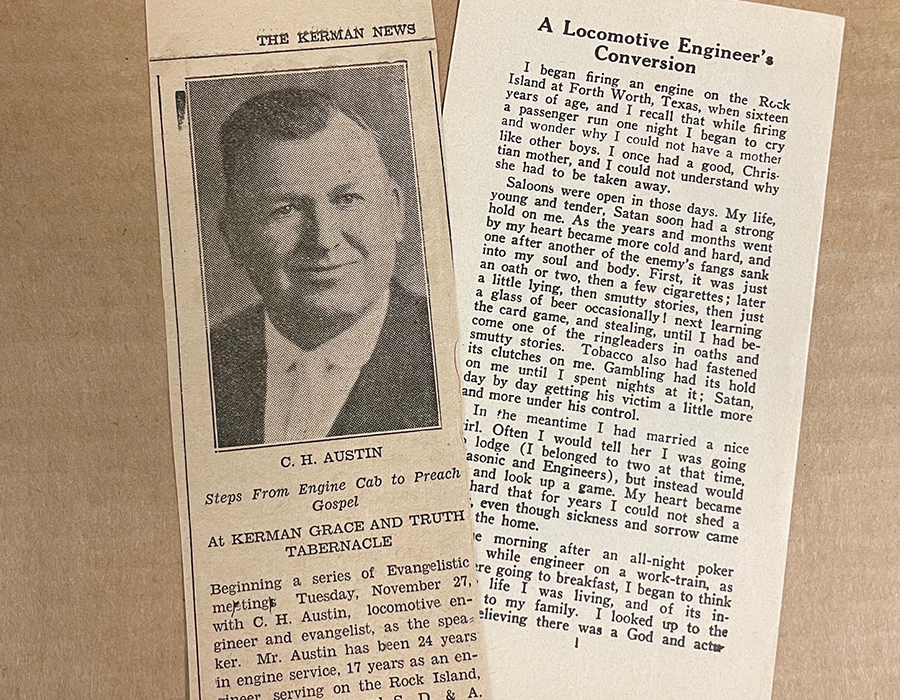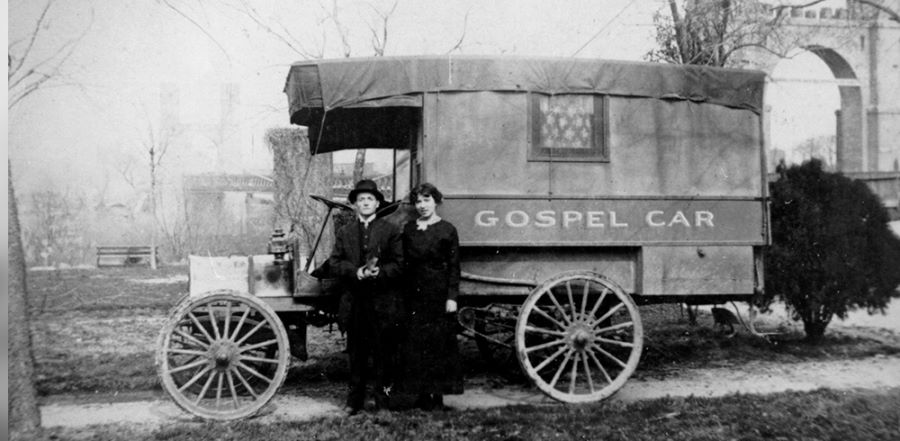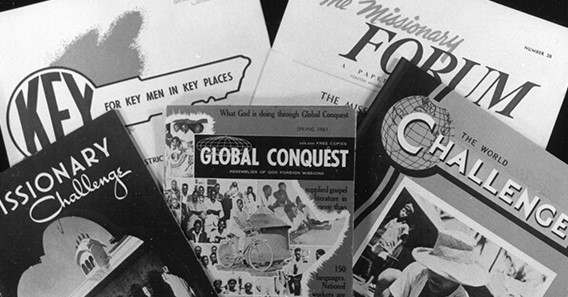
This Week in AG History — November 16, 1929
By Darrin J. Rodgers
Originally published on AG-News, 16 November 2023
Clement Henderson Austin (1889-1973) knew railroads almost as well as he knew the gospel. He spent decades working as a train engineer, but he became mired in a lifestyle of drunkenness, gambling, violence, and addictions to alcohol and tobacco.
After a dramatic conversion, Austin became an Assemblies of God evangelist. He spent the rest of his life sharing the gospel and his testimony. Austin’s story was published in a tract, which was republished in the Nov. 16, 1929, issue of the Pentecostal Evangel.
Austin’s testimony began when he was 8 years old. His life began to unravel when his mother died. For years he carried this sorrow deep inside his soul, crying himself to sleep at night. He wondered why he could not have a mother, like other boys.
As a young teenager, Austin ventured onto the streets of Fort Worth, Texas, where he quickly adapted to the ways of the world. He started firing train engines at age 16, soon becoming a train engineer. A large young man, he learned how to fend for himself.
Saloons became a second home to young Austin. He started drinking and smoking, then gambling and stealing. He prided himself on his coarse speech, later calling himself “one of the ringleaders in oaths and smutty jokes.”
Austin recalled that he was “young and tender” when he started living on the streets. But as the years progressed, he noted, “my heart became more cold and hard.” He could feel “the enemy’s fangs” as they “sank into my soul and body.”
The coarse engineer married a young woman and they had a son. Austin tried to cover up his drunken and thieving ways by lying to his wife. But he knew that his life was spinning out of control, and he felt incredible guilt over the injustice he was committing against his family. He did not want his son to follow in his footsteps.
Austin had not been to church in 12 years. While Austin had tried to ignore God, he realized he needed to turn his life around, and he knew he could not do it alone. One night, while looking into the stars, he said aloud, “O God, help me to quit gambling.” Starting at that moment, Austin’s faith — birthed out of desperation — took root.
God seemed to chase after Austin. Two weeks before his conversion, Austin was running through a dark tunnel and heard a voice say, “Throw away your tobacco.” He did, and he never tasted it again.
In the meantime, Austin’s wife began attending revival services at a Pentecostal church in San Diego, California. At first, she did not tell Austin, afraid that he might mock her. But she could not keep quiet, and she told him about the miracles she witnessed. Cripples were leaving their crutches, and deaf people could hear again. He agreed to go hear the evangelist.
The revival services were being held in a small hall, which was packed with people. Austin recalled that “people sang as if they meant it,” and he could tell they had something that he was missing. A young sailor sat next to Austin, and when the evangelist called people to the altar, he tried to pull Austin forward for prayer. Austin knew that he needed to go forward, but he did not want to publicly admit that he needed God.
An intense battle ensued between Austin’s ears. He recalled hearing a voice tell him that he was “too big a sinner” to be on his knees in church. This voice, who Austin recognized as the devil, taunted him, telling him that his drinking buddies would laugh at him. But Austin looked past his suffering, had faith in God, and cried out, “O Lord, have mercy on me.”
After an emotional spiritual battle, Austin found himself lying on the floor. He felt spiritual oppression flee, and he felt a sweet peace sweep through his soul. Austin set his heart on Christ and never looked back.
Austin told his family, friends, and coworkers about his conversion. He returned money he had stolen and asked for forgiveness from those he had offended. “There is now no more drinking, no more gambling, no more taking the name of our Lord in vain, no more tobacco,” he wrote. Instead, “old things have passed away and all things have become new.”
Austin studied for the ministry at Berean Bible Institute, an Assemblies of God school in San Diego. He graduated in 1925 and was ordained as an Assemblies of God evangelist in 1926. He continued working as an engineer on the Rock Island, Southern Pacific, and San Diego and Arizona railroads, but he viewed his secular employment as a vehicle for his higher calling — to preach the gospel across the American Southwest. During the next half century, this large, gentle, earnest railroad engineer, armed with his testimony and a Bible, touched countless lives.
Read Clement H. Austin’s testimony, “Saved and Called to Preach,” on pages 12-13 of the Nov. 16, 1929, issue of the Pentecostal Evangel.
Also featured in this issue:
• “Ten Reasons Why I Believe in Divine Healing,” by Thomas G. Atteberry
• “The Extra Portion,” by Mrs. Robert (Marie) Brown
And many more!
Click here to read this issue now.
Pentecostal Evangel archived editions courtesy of the Flower Pentecostal Heritage Center.
Do you have Pentecostal historical materials that should be preserved? Please consider depositing these materials at the Flower Pentecostal Heritage Center (FPHC). The FPHC, located in the Assemblies of God national offices, is the largest Pentecostal archive in the world. We would like to preserve and make your treasures accessible to those who write the history books.
Flower Pentecostal Heritage Center
1445 North Boonville Avenue
Springfield, Missouri 65802 USA
Phone: 417.862.1447 ext. 4400
Toll Free: 877.840.5200
Email: archives@ag.org
Website: www.iFPHC.org




 This Week in AG History —August 30, 1959
This Week in AG History —August 30, 1959
 The 2015/2016 edition of Assemblies of God Heritage magazine is hot-off-the-press and is in the mail to all Assemblies of God USA ministers and subscribers! Selected articles are also accessible for free on the
The 2015/2016 edition of Assemblies of God Heritage magazine is hot-off-the-press and is in the mail to all Assemblies of God USA ministers and subscribers! Selected articles are also accessible for free on the 



